Electric Resistance and Curing Temperature Development of Carbon Fiber-Reinforced Conductive Concrete: A Comparative Study
Abstract
:1. Introduction
2. Materials and Methods
2.1. Raw Materials
2.2. Mix Proportions and Sample Preparation
2.3. Curing Regimes
2.3.1. RT Curing Procedure
2.3.2. OH Curing Procedure
2.4. Electrical Performance Evaluation
2.4.1. Electric Resistance Measurement
2.4.2. Electric Resistance Development Factor (ERF)
2.5. Curing Temperature Measurement
2.6. Strength Test
3. Results and Discussion
3.1. Effect of Water-to-Cement Ratio on CFRCC
3.1.1. Effect of Water-to-Cement Ratio on Initial Electric Resistance
3.1.2. Effect of Water-to-Cement Ratio on Compressive Strength
3.2. Effect of Coarse Aggregate Content on Electric Resistance
3.3. Effect of Coarse Aggregate Content on Compressive Strength
3.4. Effect of CF Content on Initial Electric Resistance
3.5. Effect of CF Content on OH Curing Process
3.5.1. ERF Change
3.5.2. Curing Temperature Development
3.5.3. Strength Development
3.6. Effect of Electric Power on OH-Cured CFRCC
4. Conclusions
- (1)
- The increase in the water-to-cement ratio could improve the electrical conductivity of the CFRCC due to the increased conductive pore solution inside the sample, but could be harmful to the mechanical strength of the CFRCC.
- (2)
- The inclusion of coarse aggregate was beneficial for the electrical conductivity because it could modify the CF distribution inside the CFRCC sample. When the coarse aggregate content was lower than 20%, the increase in the coarse aggregate content could enhance the compressive strength of the CFRCC.
- (3)
- CFs could effectively modify the electrical conductivity of the CFRCC and could prolong the OH curing duration in a negative-temperature environment because of the much more stable conductive network, which increased the strength of the OH-cured concrete structure at a feasible curing temperature.
- (4)
- The electric power showed a strong relationship with the curing temperature based on the basic heat transfer theory. A higher electric power could increase the curing temperature for the OH-cured CFRCC at −20 °C, but when the electric power was too high (40 W), the OH curing process was terminated much earlier, which may be related to the destroyed conductive network inside the sample.
Author Contributions
Funding
Data Availability Statement
Conflicts of Interest
References
- Chen, S.; Xiao, H.; Tian, W.; Ma, M.; Liu, M. New insights into strain evolution of concrete under different freeze-thaw conditions: Investigation based on real-time and full-field monitoring. Cem. Concr. Res. 2024, 178, 107443. [Google Scholar] [CrossRef]
- Basheer, L.; Kropp, J.; Cleland, D.J. Assessment of the durability of concrete from its permeation properties: A review. Constr. Build. Mater. 2001, 15, 93–103. [Google Scholar] [CrossRef]
- Yue, Y.; Zhou, Y.; Xing, F.; Gong, G.; Hu, B.; Guo, M. An industrial applicable method to improve the properties of recycled aggregate concrete by incorporating nano-silica and micro-CaCO3. J. Clean. Prod. 2020, 259, 120920. [Google Scholar] [CrossRef]
- Wang, S.; Jin, H.; Deng, Y.; Xiao, Y. Comprehensive utilization status of red mud in China: A critical review. J. Clean. Prod. 2021, 289, 125136. [Google Scholar] [CrossRef]
- Zhang, G.; Yang, Y.; Li, H. Calcium-silicate-hydrate seeds as an accelerator for saving energy in cold weather concreting. Constr. Build. Mater. 2020, 264, 120191. [Google Scholar] [CrossRef]
- Alzaza, A.; Ohenoja, K.; Langås, I.; Arntsen, B.; Poikelispää, M.; Illikainen, M. Low-temperature (−10 °C) curing of Portland cement paste—Synergetic effects of chloride-free antifreeze admixture, C–S–H seeds, and room-temperature pre-curing. Cem. Concr. Compos. 2022, 125, 104319. [Google Scholar] [CrossRef]
- Mohammed, A.G.; Ozgur, G.; Sevkat, E. Electrical resistance heating for deicing and snow melting applications: Experimental study. Cold Reg. Sci. Technol. 2019, 160, 128–138. [Google Scholar] [CrossRef]
- ACI committee 306 Cold Weather Concreting. In Proceedings of the American Concrete Institute; Elsevier Ltd.: Amsterdam, The Netherlands, 2010.
- Demirboǧa, R.; Karagöl, F.; Polat, R.; Kaygusuz, M.A.; Akif, M.; Demirbog, R. The effects of urea on strength gaining of fresh concrete under the cold weather conditions. Constr. Build. Mater. 2014, 64, 114–120. [Google Scholar] [CrossRef]
- Karagol, F.; Demirboga, R.; Khushefati, W.H. Behavior of fresh and hardened concretes with antifreeze admixtures in deep-freeze low temperatures and exterior winter conditions. Constr. Build. Mater. 2015, 76, 388–395. [Google Scholar] [CrossRef]
- Liu, Y.; Yang, S.; Li, J.; Wang, F.; Hu, S. Effect of w/c ratio and antifreeze admixture on the frost damage of sulfoaluminate cement concrete at −20 °C. Constr. Build. Mater. 2022, 347, 128457. [Google Scholar] [CrossRef]
- Çullu, M.; Arslan, M. The effects of antifreeze use on physical and mechanical properties of concrete produced in cold weather. Compos. Part B Eng. 2013, 50, 202–209. [Google Scholar] [CrossRef]
- Yi, S.T.; Pae, S.W.; Kim, J.K. Minimum curing time prediction of early-age concrete to prevent frost damage. Constr. Build. Mater. 2011, 25, 1439–1449. [Google Scholar] [CrossRef]
- Kim, J.K.; Chu, I.Y.; Yi, S.T. Minimum curing time for preventing frost damage of early-age concrete. IES J. Part A Civ. Struct. Eng. 2008, 1, 209–217. [Google Scholar] [CrossRef]
- Nilimaa, J.; Zhaka, V. An Overview of Smart Materials and Technologies for Concrete Construction in Cold Weather. Energy 2023, 4, 1550–1580. [Google Scholar] [CrossRef]
- Zhang, L.; Ouyang, M.; Tian, W.; Liu, Y.; Fu, Q.; Wang, W. Internal structural evolution of conductive cementitious composites subjected to multi-step ohmic heating curing strategy under severely cold temperature. J. Build. Eng. 2023, 80, 108101. [Google Scholar] [CrossRef]
- Tian, W.; Liu, Y.; Wang, W. Enhanced ohmic heating and chloride adsorption efficiency of conductive seawater cementitious composite: Effect of non-conductive nano-silica. Compos. Part B Eng. 2022, 236, 109854. [Google Scholar] [CrossRef]
- Ouyang, M.; Tian, W.; Liu, Y.; Wang, W. Gradient power modified ohmic heating curing to prepare hybrid carbon fibers/high performance concrete under deep-freeze low temperature. Constr. Build. Mater. 2022, 330, 127279. [Google Scholar] [CrossRef]
- Tian, W.; Liu, Y.; Wang, W. Multi-structural evolution of conductive reactive powder concrete manufactured by enhanced ohmic heating curing. Cem. Concr. Compos. 2021, 123, 104199. [Google Scholar] [CrossRef]
- Ma, C.; Dai, F.; Shi, J.; Song, D.; Dong, B.; Zhou, H. Achieving energy savings and early-ages strength enhancement of prefabricated cement components: Combined application of direct electric curing and sodium sulphate. J. Clean. Prod. 2023, 425, 138802. [Google Scholar] [CrossRef]
- Ma, C.; Fan, L.; Shi, J.; Zhou, H.; Dong, B.; Song, D.; Du, Y. Direct electric curing in high early-strength sodium citrate-doped Portland cement systems for sustainable energy saving applications. Appl. Energy 2023, 347, 121381. [Google Scholar] [CrossRef]
- Wen, S.; Chung, D.D.L. The role of electronic and ionic conduction in the electrical conductivity of carbon fiber reinforced cement. Carbon 2006, 44, 2130–2138. [Google Scholar] [CrossRef]
- Wen, S.; Chung, D.D.L. Damage monitoring of cement paste by electrical resistance measurement. Cem. Concr. Res. 2000, 30, 1979–1982. [Google Scholar] [CrossRef]
- Chen, P.W.; Chung, D.D.L. Carbon fiber reinforced concrete for smart structures capable of non-destructive flaw detection. Smart Mater. Struct. 1993, 2, 22–30. [Google Scholar] [CrossRef]
- Tian, W.; Zhang, Z.; Qiu, R.; Lu, J.X.; Li, R.; Liu, Y.; Wang, W. Electrical performance of conductive cementitious composites under different curing regimes: Enhanced conduction by carbon fibers towards self-sensing function. Constr. Build. Mater. 2024, 421, 135771. [Google Scholar] [CrossRef]
- Uygunoğlu, T.; Hocaoğlu, İ. Effect of electrical curing application on setting time of concrete with different stress intensity. Constr. Build. Mater. 2018, 162, 298–305. [Google Scholar] [CrossRef]
- Xiao, H.; Li, H.; Ou, J. Strain sensing properties of cement-based sensors embedded at various stress zones in a bending concrete beam. Sens. Actuators A Phys. 2011, 167, 581–587. [Google Scholar] [CrossRef]
- Han, B.; Zhang, K.; Yu, X.; Kwon, E.; Ou, J. Electrical characteristics and pressure-sensitive response measurements of carboxyl MWNT/cement composites. Cem. Concr. Compos. 2012, 34, 794–800. [Google Scholar] [CrossRef]
- Han, B.; Zhang, L.; Zhang, C.; Wang, Y.; Yu, X.; Ou, J. Reinforcement effect and mechanism of carbon fibers to mechanical and electrically conductive properties of cement-based materials. Constr. Build. Mater. 2016, 125, 479–489. [Google Scholar] [CrossRef]
- Wilson, J.G.; Gupta, N.K. Equipment for the investigation of the accelerated curing of concrete using direct electrical conduction. Meas. J. Int. Meas. Confed. 2004, 35, 243–250. [Google Scholar] [CrossRef]
- Han, B.; Yu, X.; Kwon, E. A self-sensing carbon nanotube/cement composite for traffic monitoring. Nanotechnology 2009, 20, 445501. [Google Scholar] [CrossRef]
- Sun, S.; Han, B.; Jiang, S.; Yu, X.; Wang, Y.; Li, H.; Ou, J. Nano graphite platelets-enabled piezoresistive cementitious composites for structural health monitoring. Constr. Build. Mater. 2017, 136, 314–328. [Google Scholar] [CrossRef]
- Xu, J.; Yin, T.; Wang, Y.; Liu, L. Anisotropic electrical and piezoresistive sensing properties of cement-based sensors with aligned carbon fibers. Cem. Concr. Compos. 2021, 116, 103873. [Google Scholar] [CrossRef]
- Dehghanpour, H.; Yilmaz, K.; Afshari, F.; Ipek, M. Electrically conductive concrete: A laboratory-based investigation and numerical analysis approach. Constr. Build. Mater. 2020, 260, 119948. [Google Scholar] [CrossRef]
- Dong, S.; Dong, X.; Ashour, A.; Han, B.; Ou, J. Fracture and self-sensing characteristics of super-fine stainless wire reinforced reactive powder concrete. Cem. Concr. Compos. 2020, 105, 103427. [Google Scholar] [CrossRef]
- Dong, S.; Han, B.; Ou, J.; Li, Z.; Han, L.; Yu, X. Electrically conductive behaviors and mechanisms of short-cut super-fine stainless wire reinforced reactive powder concrete. Cem. Concr. Compos. 2016, 72, 48–65. [Google Scholar] [CrossRef]
- Wang, Z.; Wang, Z.; Ning, M.; Tang, S.; He, Y. Electro-thermal properties and Seebeck effect of conductive mortar and its use in self-heating and self-sensing system. Ceram. Int. 2017, 43, 8685–8693. [Google Scholar] [CrossRef]
- Kim, G.M.; Yang, B.J.; Yoon, H.N.; Lee, H.K. Synergistic effects of carbon nanotube and carbon fiber on heat generation and electrical characteristics of cementitious composites. Carbon 2018, 134, 283–292. [Google Scholar] [CrossRef]
- Donnini, J.; Bellezze, T.; Corinaldesi, V. Mechanical, electrical and self-sensing properties of cementitious mortars containing short carbon fibers. J. Build. Eng. 2018, 20, 8–14. [Google Scholar] [CrossRef]
- Tian, W.; Li, R.; Zhang, Z.; Wang, M.; Liu, Y.; Lu, J.X.; Jia, Y.; Wang, W. Curing parameters development and long-term performance of ohmic heating cured conductive cementitious composites: A comparative study on fiber fraction. J. Build. Eng. 2024, 91, 109566. [Google Scholar] [CrossRef]
- Jiang, L.; Liu, Z.; Yu, Y.; Ben, X. The effect of graphene on the conductivity of magnesium sulfate cement. Constr. Build. Mater. 2021, 312, 125342. [Google Scholar] [CrossRef]
- Malakooti, A.; Maguire, M.; Thomas, R.J. Evaluating Electrical Resistivity as a Performance Based Test for Utah Bridge Deck Concrete; No. CAIT-UTC-NC35; Rutgers University, Center for Advanced Infrastructure and Transportation: Newark, NJ, USA, 2018. [Google Scholar]
- Wu, T.; Huang, R.; Chi, M.; Weng, T. A study on electrical and thermal properties of conductive concrete. Comput. Concr. 2013, 12, 337–349. [Google Scholar] [CrossRef]
- Zhang, J.; Bian, F.; Zhang, Y.; Fang, Z.; Fu, C.; Guo, J. Effect of pore structures on gas permeability and chloride diffusivity of concrete. Constr. Build. Mater. 2018, 163, 402–413. [Google Scholar] [CrossRef]
- Zhang, L.; Ding, S.; Li, L.; Dong, S.; Wang, D.; Yu, X.; Han, B. Effect of characteristics of assembly unit of CNT/NCB composite fillers on properties of smart cement-based materials. Compos. Part A Appl. Sci. Manuf. 2018, 109, 303–320. [Google Scholar] [CrossRef]
- ASTM C109/C109M; Standard Test Method for Compressive Strength of Hydraulic Cement Mortars (Using 2-in. or [50-mm] Cube Specimens). ASTM International: West Conshohocken, PA, USA, 2013.
- Liu, Y.; Wang, M.; Tian, W.; Qi, B.; Lei, Z.; Wang, W. Ohmic heating curing of carbon fiber/carbon nanofiber synergistically strengthening cement-based composites as repair/reinforcement materials used in ultra-low temperature environment. Compos. Part A Appl. Sci. Manuf. 2019, 125, 105570. [Google Scholar] [CrossRef]
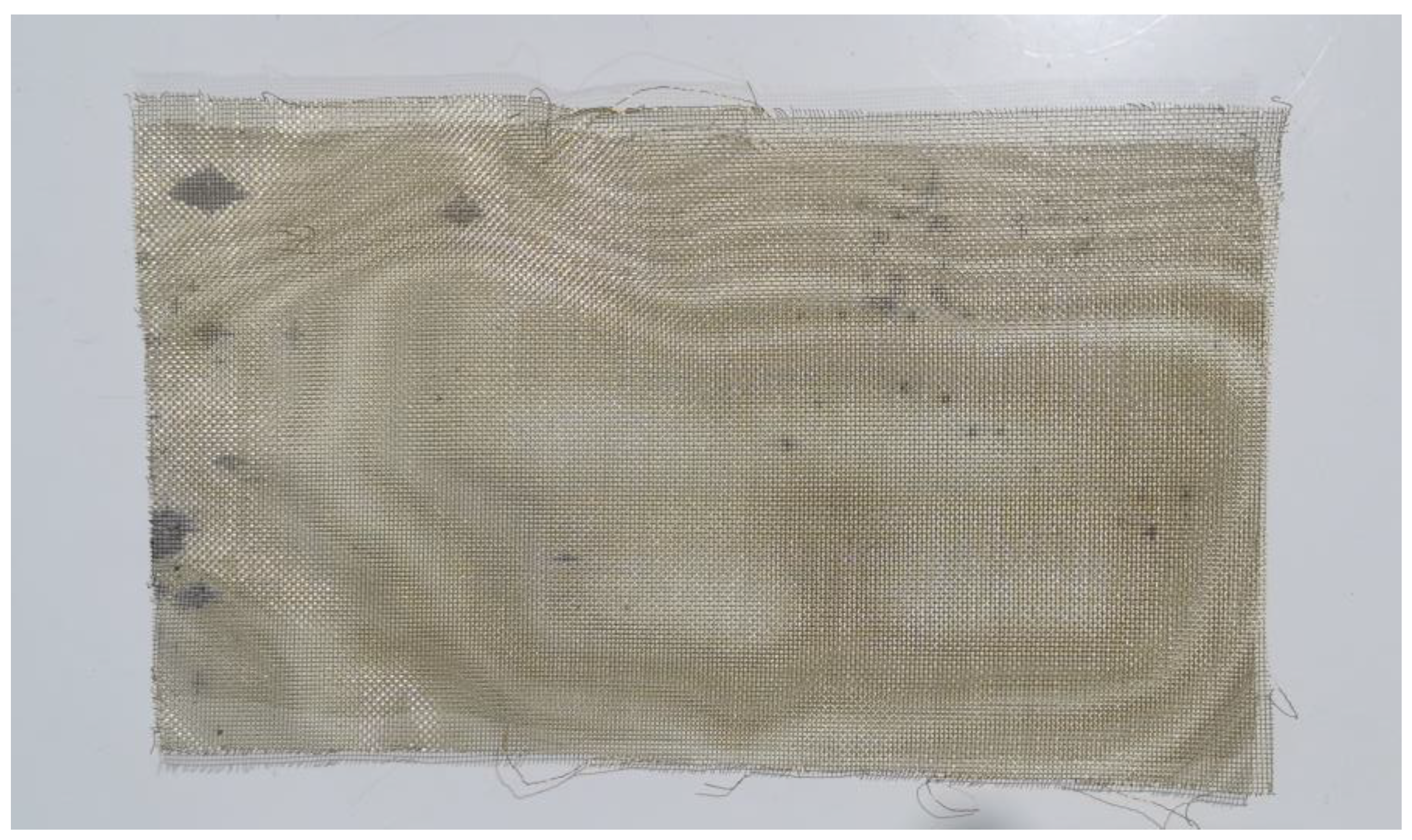
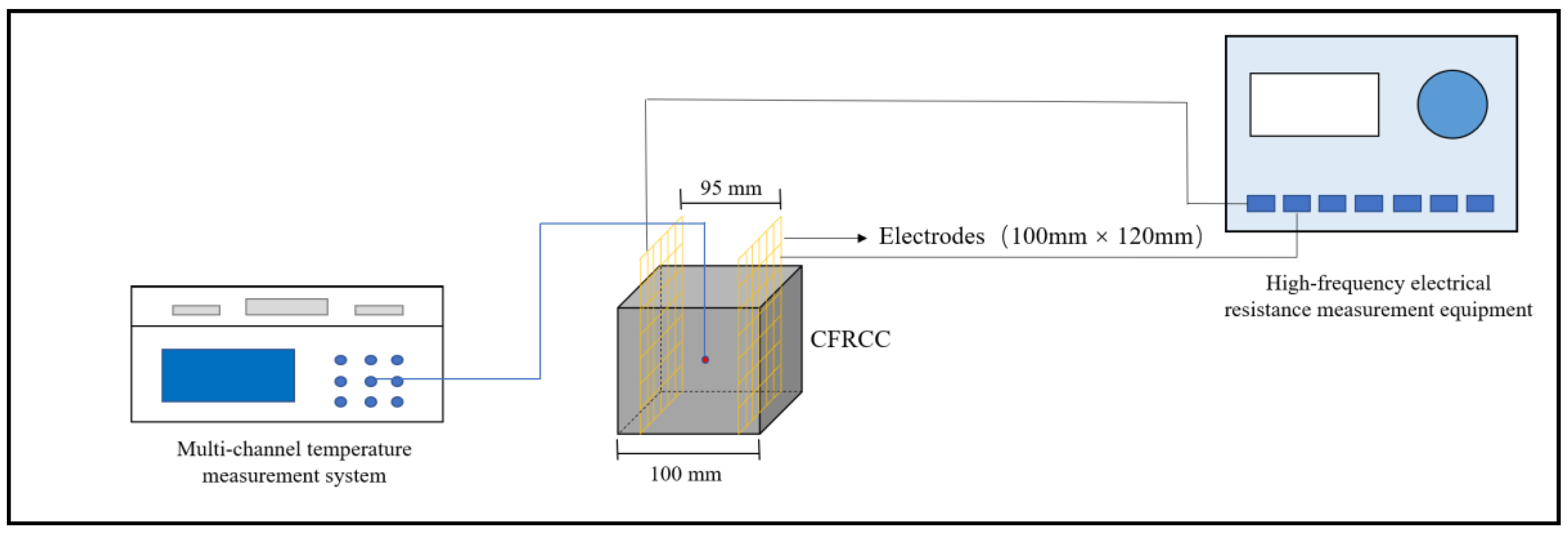
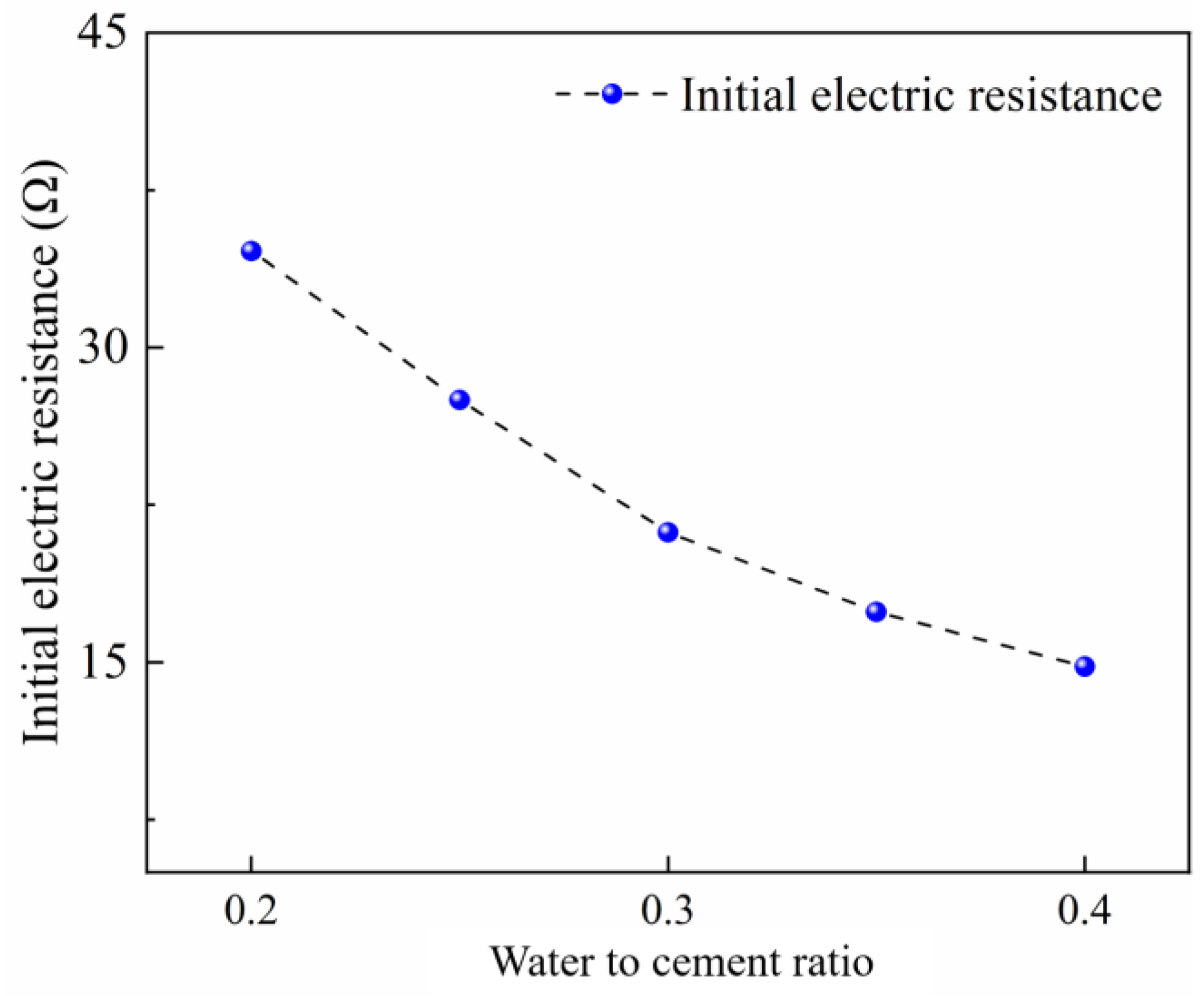

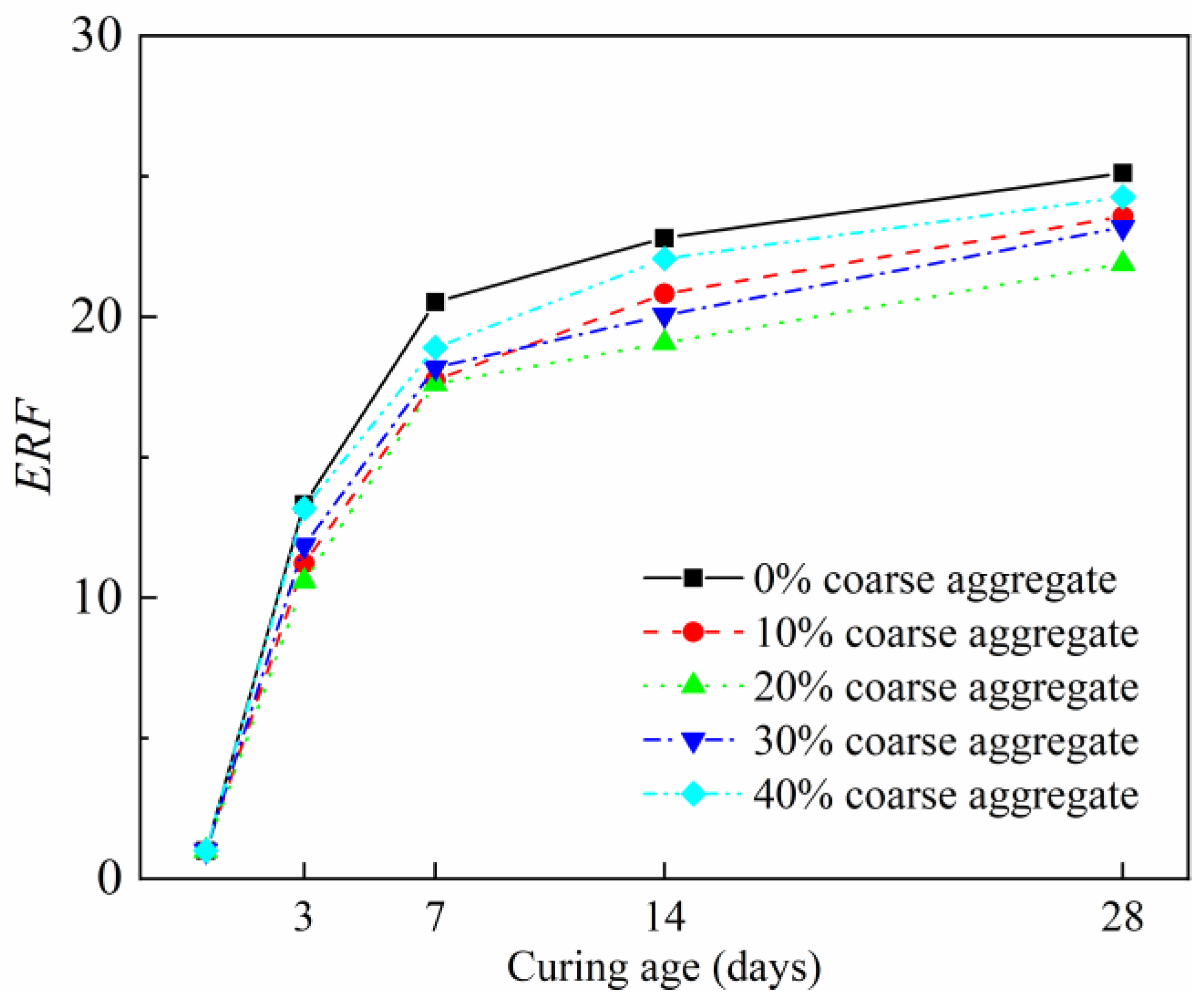
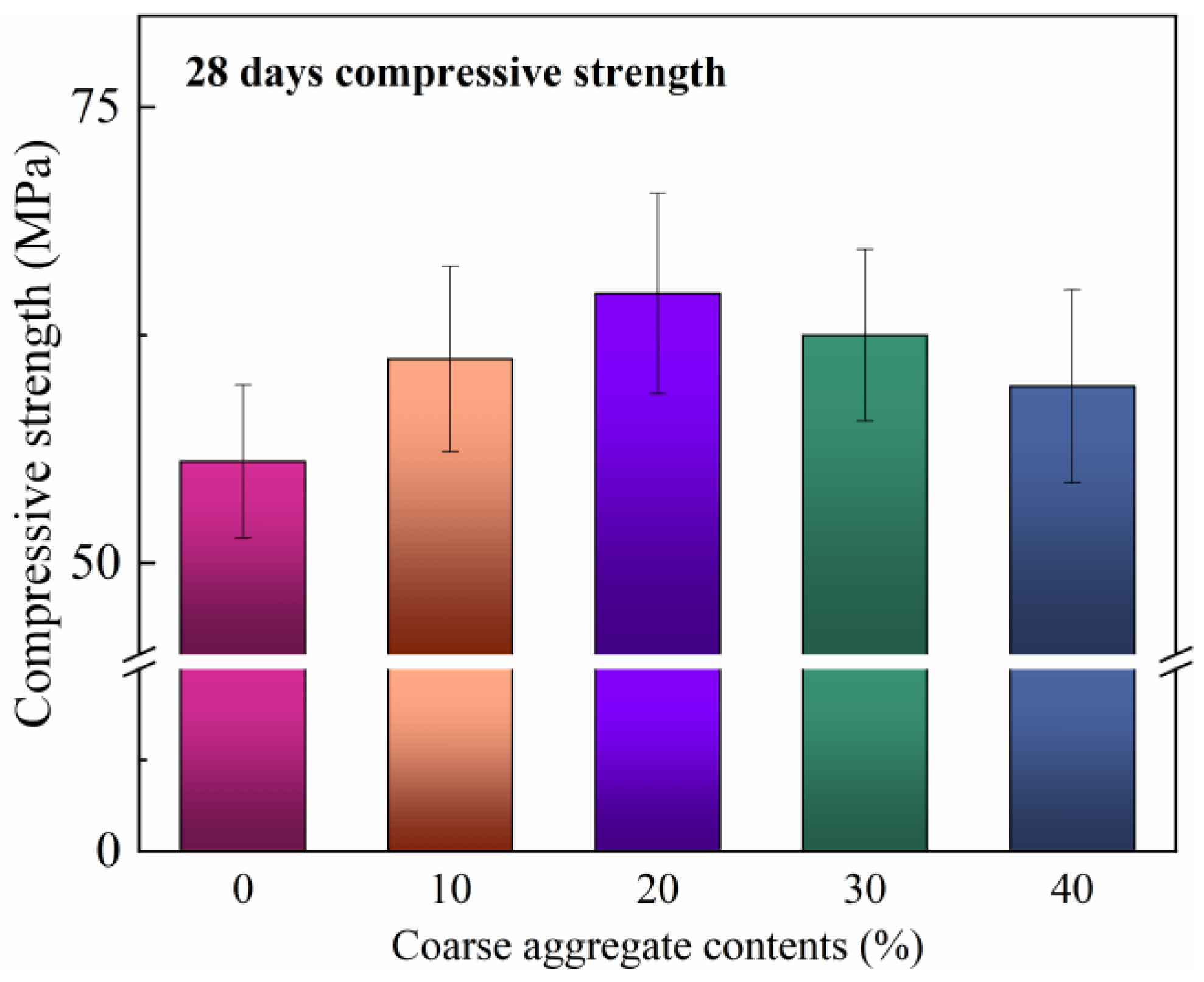
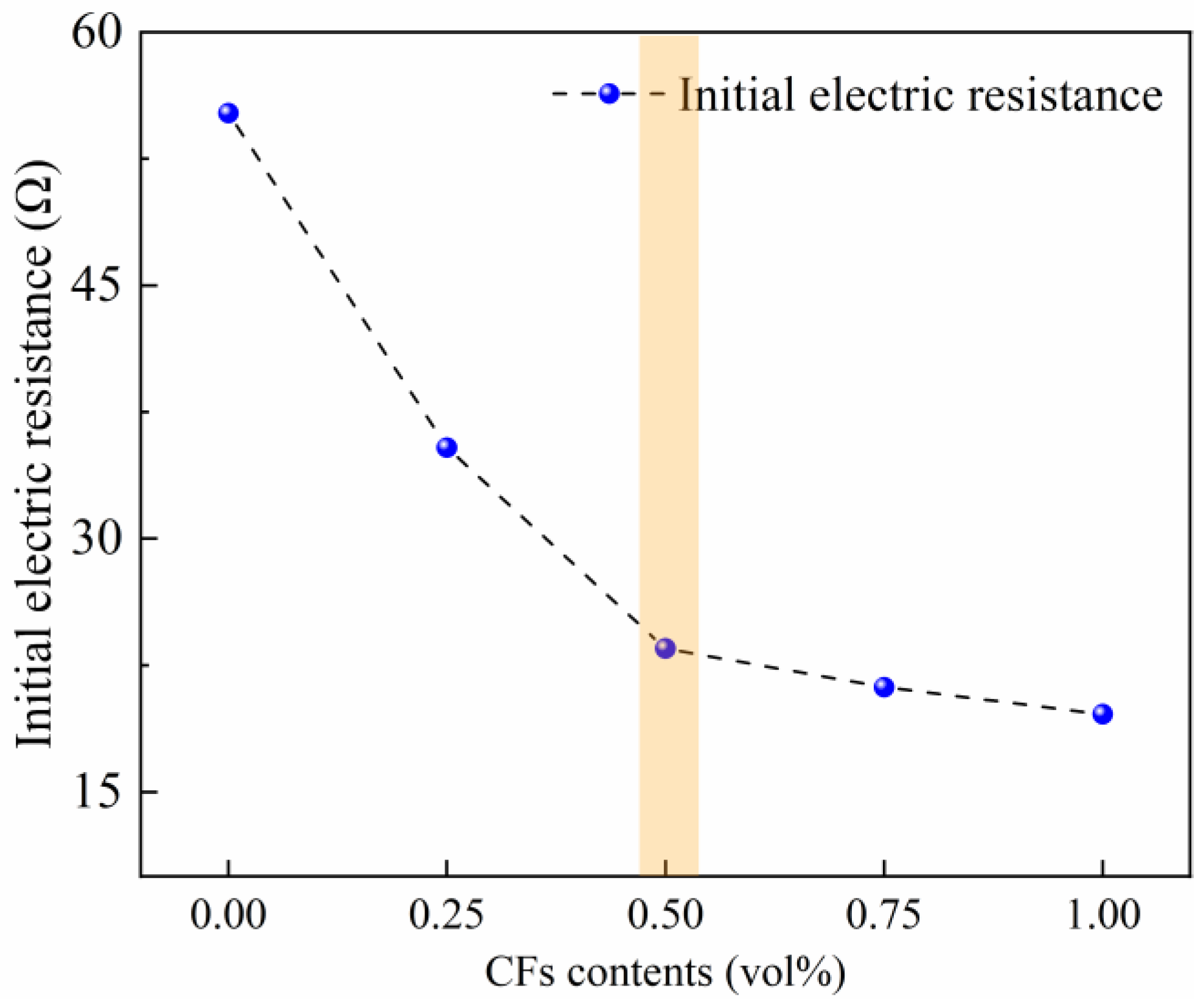
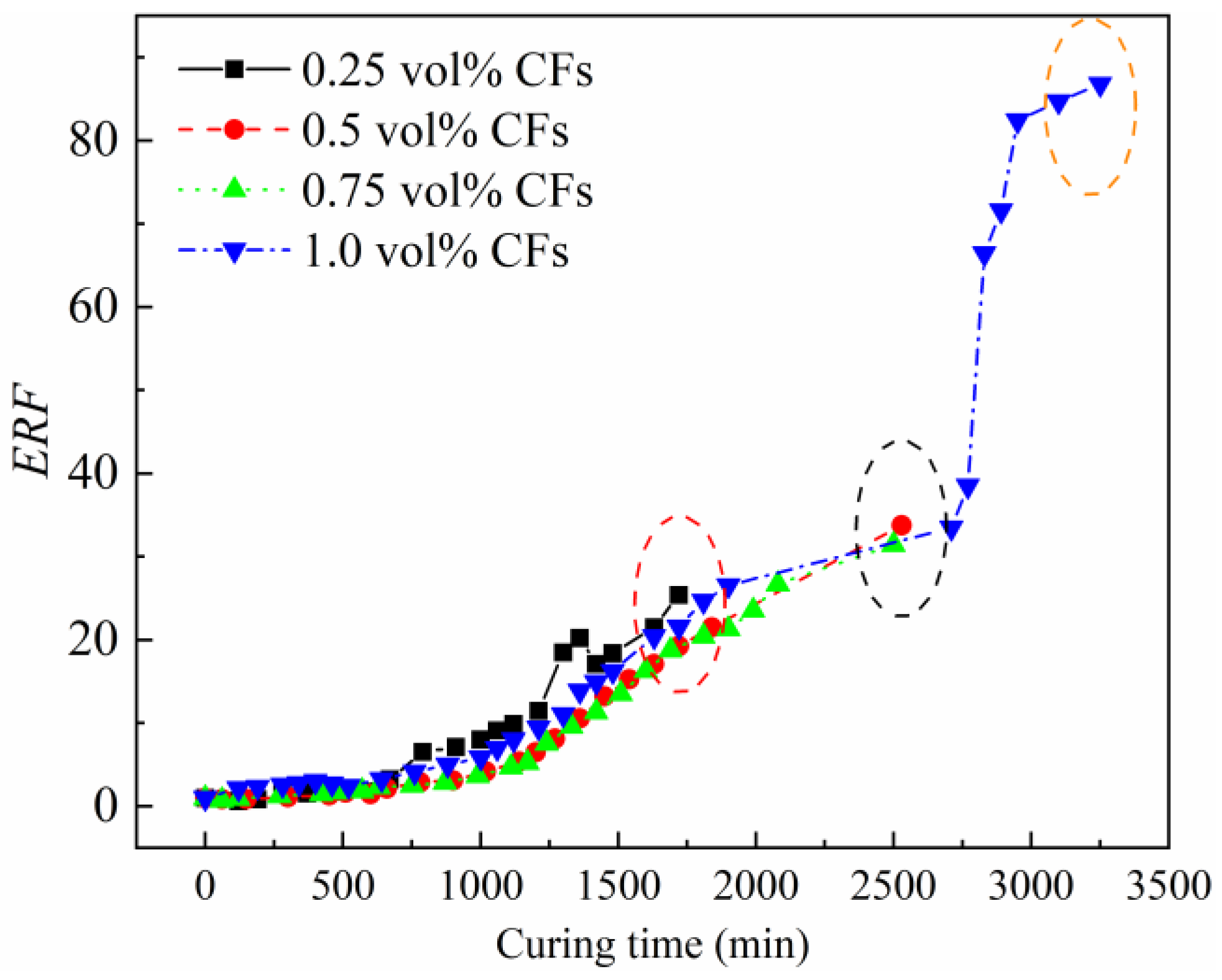
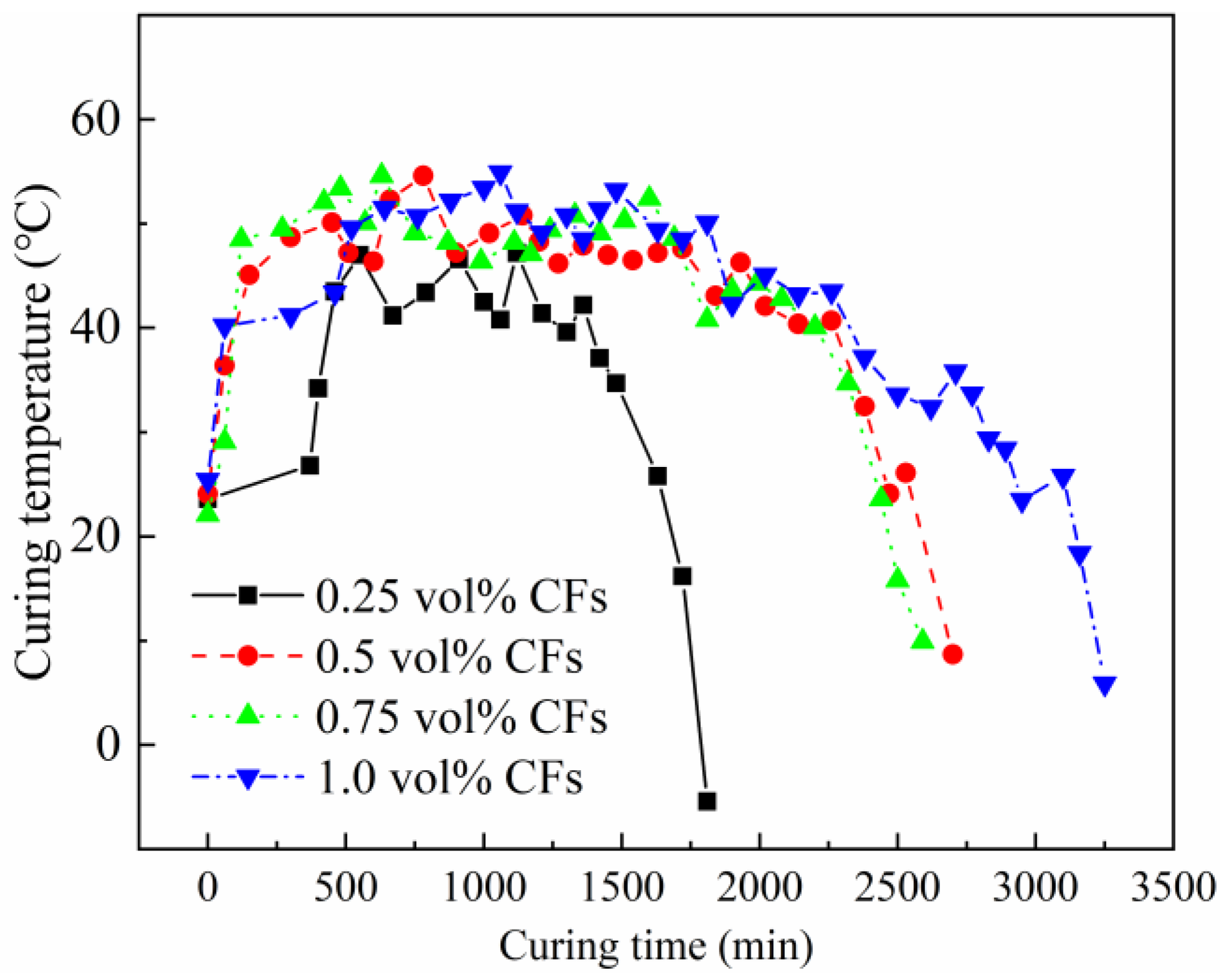

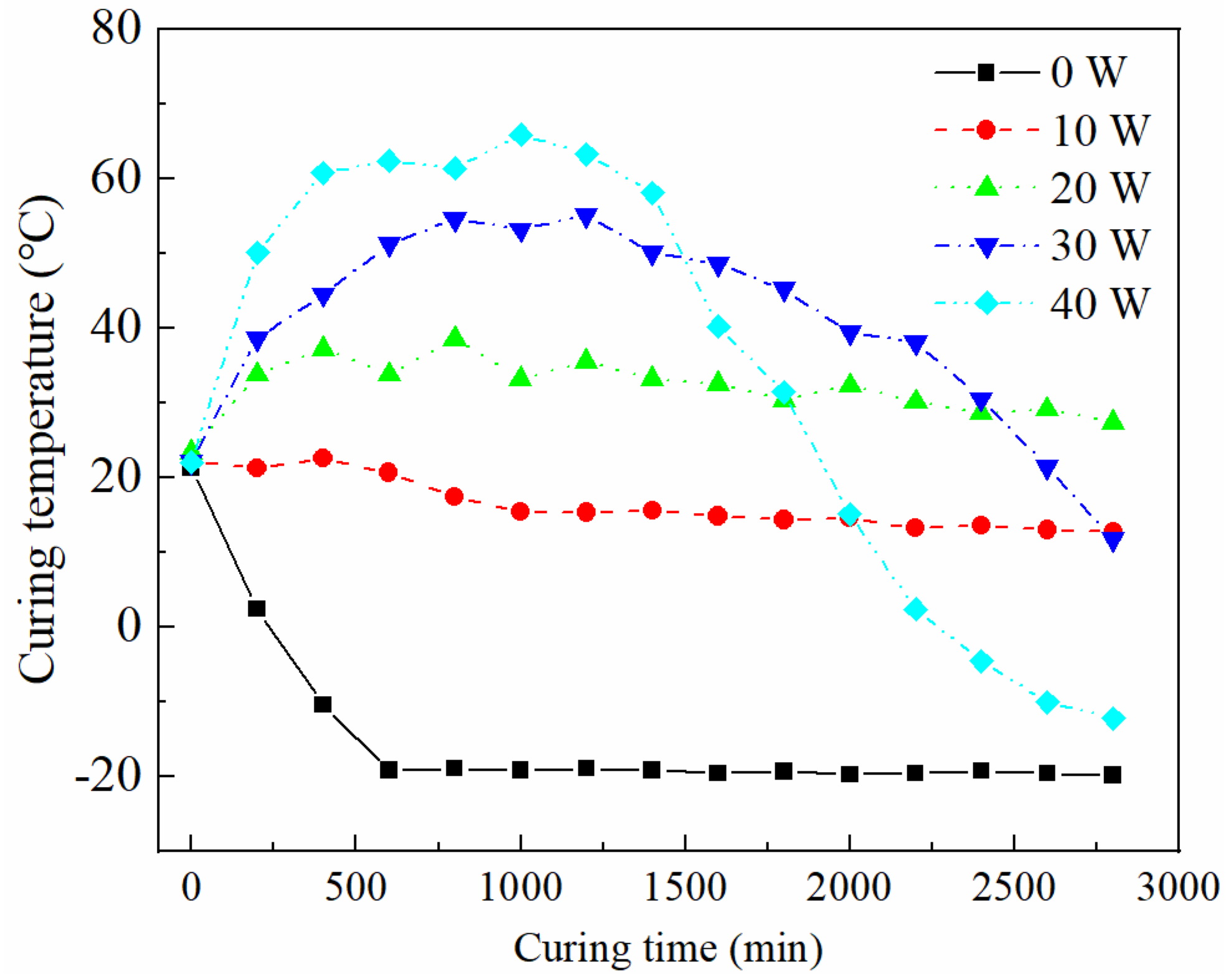
Disclaimer/Publisher’s Note: The statements, opinions and data contained in all publications are solely those of the individual author(s) and contributor(s) and not of MDPI and/or the editor(s). MDPI and/or the editor(s) disclaim responsibility for any injury to people or property resulting from any ideas, methods, instructions or products referred to in the content. |
© 2024 by the authors. Licensee MDPI, Basel, Switzerland. This article is an open access article distributed under the terms and conditions of the Creative Commons Attribution (CC BY) license (https://creativecommons.org/licenses/by/4.0/).
Share and Cite
Zhang, L.; Chen, S.; Tian, W.; Tang, Y.; Fu, Q.; Li, R.; Wang, W. Electric Resistance and Curing Temperature Development of Carbon Fiber-Reinforced Conductive Concrete: A Comparative Study. Materials 2024, 17, 4045. https://doi.org/10.3390/ma17164045
Zhang L, Chen S, Tian W, Tang Y, Fu Q, Li R, Wang W. Electric Resistance and Curing Temperature Development of Carbon Fiber-Reinforced Conductive Concrete: A Comparative Study. Materials. 2024; 17(16):4045. https://doi.org/10.3390/ma17164045
Chicago/Turabian StyleZhang, Lei, Siyuan Chen, Weichen Tian, Yuan Tang, Qiang Fu, Ruisen Li, and Wei Wang. 2024. "Electric Resistance and Curing Temperature Development of Carbon Fiber-Reinforced Conductive Concrete: A Comparative Study" Materials 17, no. 16: 4045. https://doi.org/10.3390/ma17164045
APA StyleZhang, L., Chen, S., Tian, W., Tang, Y., Fu, Q., Li, R., & Wang, W. (2024). Electric Resistance and Curing Temperature Development of Carbon Fiber-Reinforced Conductive Concrete: A Comparative Study. Materials, 17(16), 4045. https://doi.org/10.3390/ma17164045






